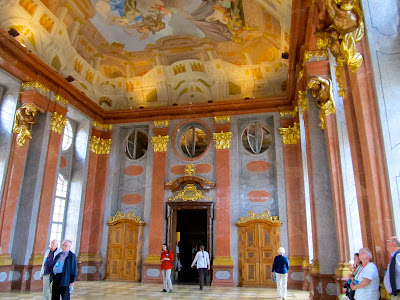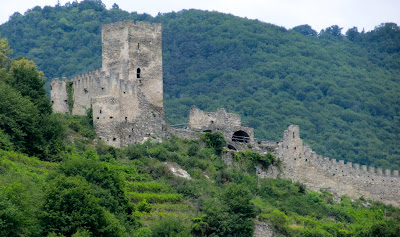Founded in the 11th century, the current Benedictine abbey was constructed in the early 1700s. Below is the entrance to the grounds with its winding stairway and pretty little view. And beneath that is the courtyard where we cooled our heels before the official tour started.
They had remodeled the abbey museum in recent years and one of my favorite things was the colored lighting in some of the rooms and how it made this huge heater look otherworldly.
Here is a pic of our abbey guide in front of some beautiful altar paintings. And underneath that is a scaled replica of the current abbey - quite large for the 30ish monks who currently belong to the order. It seems a big chunk of the abbey houses a school for hundreds of students. The library was amazing, but no pics were allowed since it was filled with medieval manuscripts. Illuminated manuscripts truly are works of art with all of the meticulous hand lettering and detail.
On the tour, our guide pointed out an old form of volume control. See the three windows at the top of the pic below? The musical ensemble was seated in a gallery on the other side of the windows, which can be adjusted to control the volume of music at soirees. Pretty nifty, huh.
The church sits at the end of the abbey grounds overlooking the river. You can't help but be impressed with the interiors of these Baroque churches - just gorgeous to behold.
I love the pic above, an employee or volunteer dusting one of the side altars. In between the candles, you can just make out the glass sarcophagus which contains a "catacomb saint" given to the monastery that has been dubbed Clemens. It's hard to tell here, but the skeleton is kinda striking a macabre pose reclined on his side with his hand propping up his head.
On the walk back through Melk to reboard the ship, we passed a building with the high water marks for floods down through the centuries.
We had seen one just like it in Passau the day before. It dates back to the 1500s - very cool.
By 1:00 pm, our ship had set sail through the scenic Wachau Valley. This region is famous for its picturesque terraced vineyards.
Castle ruins always fascinate me and we passed by a couple of them.
The ruins below are of Durnstein Castle. Richard I (Richard the Lionheart), King of England in the 12th century, was held prisoner here briefly. The castle was later destroyed by the Swedes in the 16th century and this is all that remains. One of these days, I would love to have sufficient time and funds to take a leisurely tour of Germany's Castle Road. Mannheim to Prague, stretching 975 km with something like 70 castles and fortresses along the route - HEAVEN to a history nerd like me.
We ended the evening with some drawling dinner companions - the Aggies introduced us to a nice couple from Livingston, Texas.




















No comments:
Post a Comment